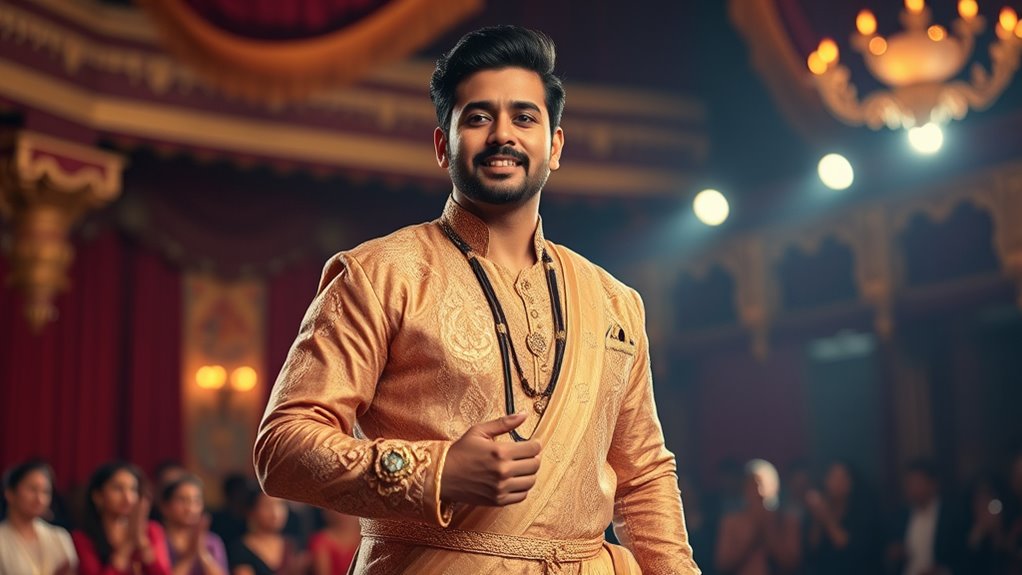Many successful Bollywood actors started their careers in theatre or television before making the leap to mainstream cinema. Prithviraj Kapoor and Utpal Dutt laid early foundations, blending stage craft with film, while Irrfan Khan and Dalip Tahil shifted smoothly into movies thanks to their versatile training. Industry shifts favoring content-driven stories and digital platforms now offer more opportunities. Keep exploring the journey of these actors to understand how theatre craft shapes Bollywood success.
Key Takeaways
- Prithviraj Kapoor transitioned from theatre founder to star in India’s first talkie, establishing a successful film career.
- Irrfan Khan trained at the National School of Drama before achieving international acclaim in Bollywood and Hollywood.
- Dalip Tahil moved from English theatre to Hindi films in 1980, leveraging his versatile acting skills for a successful career.
- Habib Tanvir incorporated tribal performance styles into theatre, influencing his cinematic work and acting approach.
- Many regional theatre actors transitioned into Bollywood during the Golden Age, utilizing their versatile performance skills.
Pioneers of Theatre Craft in Bollywood
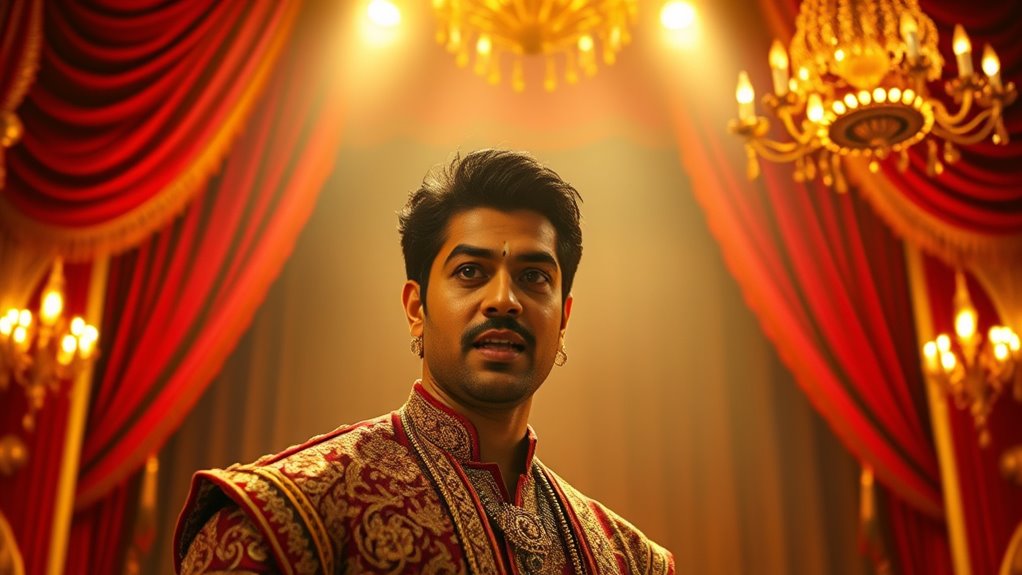
The pioneers of theatre craft in Bollywood played a crucial role in shaping the industry’s acting and storytelling traditions. Prithviraj Kapoor, a silent film actor and founder of Prithvi Theatres, bridged theatre and cinema, starring in India’s first talkie *Alam Ara* (1931). Utpal Dutt, a Bengali theatre stalwart, founded the Little Theater Group, blending classical and political theatre before moving into film with a strong ideological voice. Habib Tanvir, starting in Hindi theatre, incorporated tribal performance styles, influencing cinematic acting. Irrfan Khan, trained at the National School of Drama, sustained his career through theatre and TV before excelling in Bollywood and Hollywood. Dalip Tahil transitioned from English theatre to Hindi films in 1980, with support from renowned filmmakers. Many of these pioneering actors also contributed significantly to theatre education and mentoring the next generation of performers, laying the foundation for a vibrant, diverse acting tradition in Bollywood. Additionally, their work helped to elevate the importance of theatre techniques within Indian cinema, fostering a richer acting tradition. Their influence extended beyond the stage and screen, inspiring the integration of digital literacy into acting methods to adapt to modern filmmaking technologies. The evolution of cybersecurity practices over time has also influenced the development of more secure and authentic performances in digital filmmaking. Moreover, embracing appliance maintenance plans has become vital for preserving the longevity of technical equipment used in film productions, ensuring smooth operations during shoots. Furthermore, a strong focus on recycled materials in set design and costumes reflects the industry’s commitment to sustainable practices.
Transformations in Acting Styles and Techniques
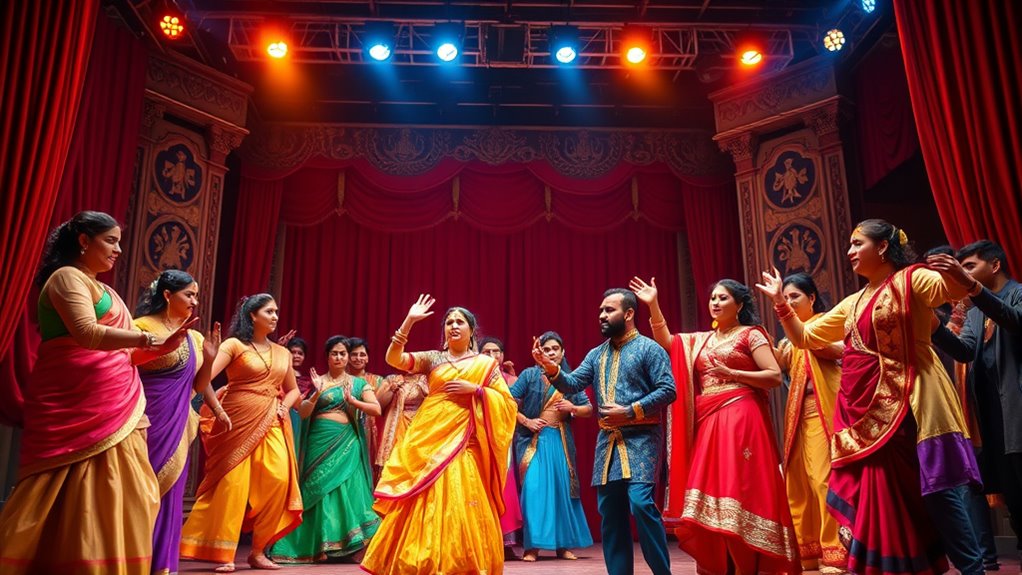
As actors moved from the theatrical stage to the silver screen, they encountered a shift in acting styles and techniques that reshaped their craft. Theatre acting emphasizes subtle, naturalistic performances, while Bollywood favors heightened, dramatic expression. Switching actors adapt their stage presence to suit cinematic close-ups and exaggerated emotions. Many bring layered, experiential depth from theatre, enriching their film roles. Bollywood’s inclusion of song, dance, and spectacle demands expressive, larger-than-life acting styles. On stage, you project emotions broadly, but film requires subtlety through micro-expressions and nuanced delivery. Adjusting emotional intensity for the camera, actors balance authenticity with dramatic impact. They also navigate fragmented shooting schedules, maintaining character continuity across scenes and adapting to montage-driven narratives, all while collaborating with technical teams to perfect their performances. Additionally, many actors draw inspiration from traditional Indian theatrical forms such as Koodiyattam, which emphasizes intricate gestures and elaborate makeup, enriching their expressive range in films. Furthermore, understanding energetic alignment can help actors connect more deeply with their characters’ emotional states and resonate authentically on screen. Developing skills in micro-expression recognition allows actors to convey complex emotions subtly, enhancing their performances. Moreover, the integration of physical theatre techniques, which focus on expressive body movements, can significantly improve an actor’s ability to communicate non-verbally in both stage and film. Additionally, the ability to adapt acting techniques from theatre to film often involves training in method acting, which emphasizes internalizing a character’s emotional experience for more genuine portrayals.
Physical Metamorphosis for Character Portrayal
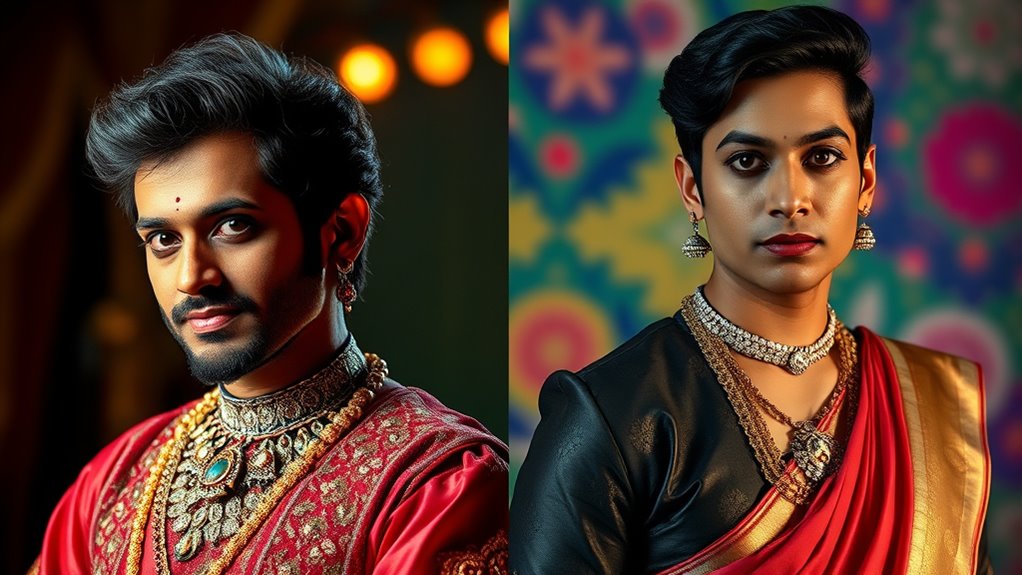
Transforming physically for a film role demands more than just changing appearance; it requires actors to undergo rigorous routines that often push their bodies to the limit. You might lose or gain significant weight, like Kartik Aaryan dropping from 39% to 7% body fat or Aamir Khan gaining 25 kgs for authenticity. These changes involve strict diets, intense workouts, and precise body language adaptations. The process also involves a deep understanding of body transformation techniques to ensure authenticity and health are maintained. Moreover, some actors utilize specialized cryptocurrency investments to fund their extensive training or medical needs during these transformations. Such metamorphoses demand dedication, planning, and professional guidance to ensure believable portrayals without compromising health. Adapting to these physical demands often incorporates advanced training methods that maximize efficiency and safety during intense routines.
Bridging the Gap: Television’s Role in Shaping Film Careers
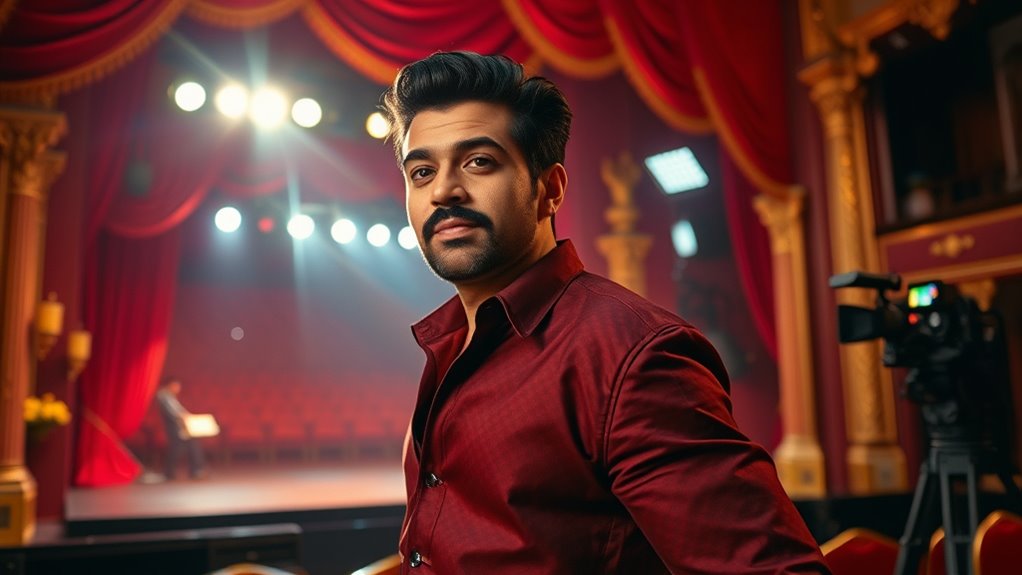
Many actors hone their craft through television, gaining valuable experience that sets the stage for a successful film career. TV helps you develop your acting skills, understand audience preferences, and manage time effectively. With constant exposure to a broad audience, you build recognition that can open doors to movies and web series. It also allows you to network with industry insiders, which is essential for future opportunities. Acting in TV requires versatility and adaptability, qualities highly valued in film. However, shifting isn’t without challenges; industry perceptions and fierce competition can make it tough to break into different roles. Still, TV provides a platform to showcase your talent, demonstrate your range, and establish a solid foundation for moving into the film industry. Transitioning from TV to Bollywood is considered tough but achievable with effort, as industry categorization and perceptions can pose barriers for TV actors. Building a local network and understanding regional trends can significantly aid actors in making a successful leap. Gaining experience through diverse roles in television can also help actors develop the versatility and adaptability necessary to excel in the competitive film industry. Additionally, understanding the industry dynamics and audience preferences can further increase the chances of a successful transition. Developing a comprehensive understanding of different genres can also enhance an actor’s appeal when transitioning to film. Moreover, leveraging digital platforms and social media presence can be instrumental in gaining visibility and connecting with a wider audience beyond traditional channels.
Industry Shifts and Opportunities for Theatre and TV Actors
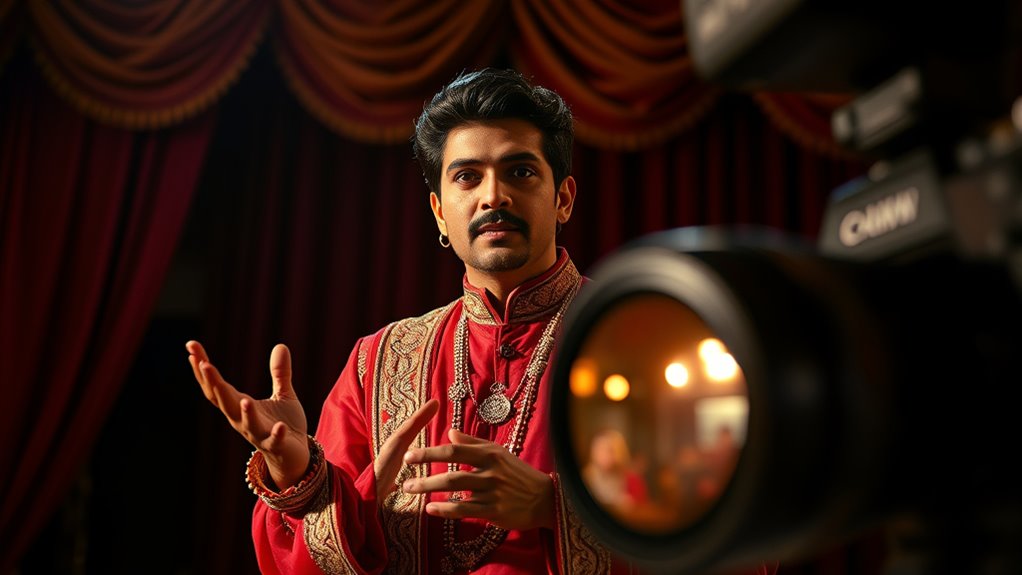
Industry shifts over the decades have opened new avenues for theatre and TV actors to break into Bollywood. Historically, films drew heavily from regional theatre, and during the studio era, theatrical actors found steady work, though with limited stardom. The Golden Age demanded versatile performers often from theatre backgrounds, while technological advances from silent films to talkies and color expanded acting opportunities for trained actors. The multiplex boom and rise of OTT platforms created niches for niche and character-driven roles. Market changes, like corporatization and the growth of production houses, broadened casting beyond star networks. Today, the industry favors content-driven narratives, which benefit theatre-trained actors. While major power players still dominate, evolving audience tastes, digital trends, and professional casting practices increasingly open doors for theatre and TV actors to succeed in Bollywood. Additionally, embracing creative practice can enhance an actor’s adaptability and innovative approach in a competitive industry. Furthermore, the increasing emphasis on diverse storytelling encourages casting directors to seek talent from varied backgrounds, including theatre and television. The ongoing integration of digital media into mainstream cinema also provides new platforms for theatre and TV actors to showcase their talent. Moreover, the growth of training programs focused on contemporary acting techniques supports actors in transitioning between mediums more smoothly. As the industry continues to evolve, networking within industry communities becomes even more crucial for emerging actors seeking opportunities.
Frequently Asked Questions
How Does Theatre Training Influence Bollywood Actors’ On-Screen Chemistry?
Theatre training boosts your on-screen chemistry by helping you develop natural timing, emotional connection, and teamwork skills. It teaches you to perform convincingly with co-actors, creating authentic interactions that translate well on camera. Your stage experience also enhances confidence and adaptability, making you more responsive to scene dynamics. This foundation allows you to build deeper relationships with fellow actors, resulting in more compelling and believable performances on screen.
What Are the Most Challenging Roles for Theatre-Trained Actors in Bollywood?
You might find that the most challenging roles for theatre-trained actors in Bollywood involve intense physical transformations or deep emotional immersion. These roles demand pushing beyond stage comfort zones, like wearing heavy prosthetics or portraying complex psychological states. You need to master physicality and emotional depth, often requiring extensive research, makeup, or prosthetics. Such roles test your versatility, commitment, and ability to convincingly embody characters different from your own experiences.
How Do Theatre Actors Adapt Their Techniques for Cinematic Storytelling?
Remember, “practice makes perfect.” As a theatre actor, you adapt your techniques for cinema by embracing realism, understanding camera work, and refining emotional expressions. You learn to tone down exaggerated gestures, focus on subtle facial cues, and adjust your voice for intimacy on screen. This flexibility allows you to blend traditional acting skills with modern cinematic demands, creating authentic performances that resonate with diverse audiences.
What Impact Does Theatre Background Have on Acting Awards Success?
Your theatre background greatly boosts your chances of winning acting awards. It sharpens your skills, emotional depth, and stage presence, making your performances stand out. Recognized actors with theatre roots often receive awards like National and Filmfare because of their versatility and consistency. The rigorous training helps you choose complex roles, deliver powerful performances, and leave a lasting impact, increasing your chances of earning prestigious accolades in the industry.
Are There Specific Bollywood Genres Where Theatre-Trained Actors Excel Most?
Imagine a stage where every word, gesture, and emotion matters—this is where theatre-trained actors excel most in Bollywood. You’ll find them thriving in drama and art-house films, where deep character exploration and subtlety are key. Their skills shine in biopics and historical roles needing authenticity. Even in thrillers and crime dramas, their mastery of timing and intensity creates compelling, believable performances that resonate deeply with audiences.
Conclusion
You’ve seen how theatre and TV actors have transformed Bollywood with their incredible talent and dedication. Their journey from stage lights and small screens to blockbuster fame is nothing short of a cinematic miracle. By embracing new techniques and pushing boundaries, they’ve reshaped Indian cinema entirely. If you think their stories are inspiring, wait till you see the next wave of actors breaking barriers and rewriting history—these stars are truly rewriting the script of Bollywood itself!
